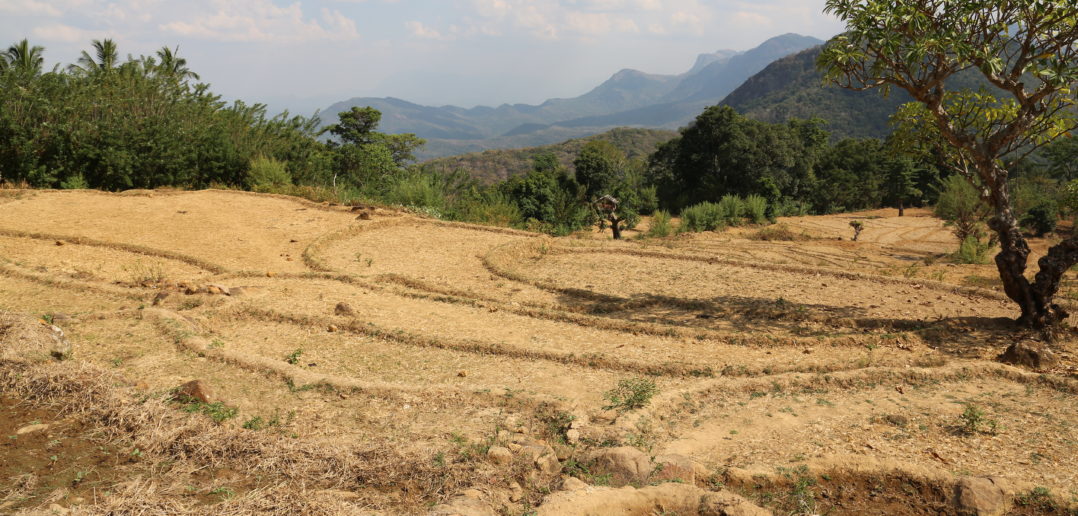Image:Dry terraced fields due to drought, Sri Lanka. (Credit: Bioversity International/S/Landersz/Flickr)
BY JOANNE LU.
From floods to drought – there’s no reprieve for Sri Lanka. Unfortunately, it will only get worse with climate change, unless the government commits to some immediate improvements.
More than 800,000 people in all nine provinces of Sri Lanka have been affected by the latest dry spell, according to the most recent data from the national Disaster Management Center. Numbers have varied over the course of the drought, but the government is now providing drinking water for less than 150,000 of those people. Nearly 1,000 people are currently in immediate need of a drinking water supply.
At 5,000 rupees ($34), a personal tank of water is far too expensive for most villagers. Instead, when the government supply is insufficient or delayed, people are relying on small-scale vendors who charge four to 10 rupees (three to seven cents) for each one-liter bottle.
Everything else – cooking, hygiene, farming – must rely on whatever limited or unsanitary water sources are available.
“It has been like this for over three months now,” Ranjith Jayarathne, a farmer, told Inter Press Service. Unfortunately, he and everyone else must ride out a few more weeks of drought before heavy rains are due to return in mid-November.
Sri Lanka may be praying for rain now, but just before the drought in May, torrential rains and cyclones caused massive flooding, landslides and more than $3 billion in damages, according to the Finance Ministry.
“This is what we undergo every year. After the floods, there will be a drought, and we are almost dying of thirst,” Tissa Poddibanda, another farmer, told Thomson Reuters.
It’s a cycle that is only destructive. Floods kill hundreds, displace thousands and destroy livestock, stored food, agriculture and infrastructure. Then drought hits, further undermining food and water security and growth.
It’s also a cycle made worse by climate change, increasing in frequency and intensity.
The Asian Development Bank (ADB) estimated in a recent study that if business continues as usual, Southeast Asia will suffer a collective gross domestic product (GDP) loss of 11 percent by 2100, a larger economic loss from climate change than most areas of the world.
As desperate as the situation may seem, mitigating solutions are not out of reach. Sri Lanka has signed and ratified the Paris Agreement on climate change – a step in the right direction. But so much more can and needs to be done immediately.
“There is a lack of awareness about climate change impacts on livelihood among farmers and local government officials, especially those engaged in water management and agriculture extension,” said an August report on coping with climate change in Sri Lanka by the U.N. Development Program (UNDP), the Global Environment Facility and the government of Australia.
Educating farmers is a major component of coping with weather variability, especially when 80 percent of the region’s water resources are consumed by agriculture.
The report said that community leaders should advise farmers of water-saving methods, different crop choices and means of diversifying their livelihoods to minimize their dependence on predictable rainfall.
Government agencies must also be willing to coordinate closely with civil society organizations, local communities and among themselves, as competing demands for water increase between agriculture, power, disaster management and household sectors.
For example, Inter Press Service reported that the irrigation department currently has water in storage. Yet, the department is unwilling to release the water for domestic use amid the drought for fear of running a shortage in November during rice paddy season, when farmers expect free irrigation water.
“We need a much more cohesive water-management policy to safely release water stored for agriculture,” S.L. Weerasinghe, director-general of the irrigation department, told Reuters.
Mismanagement of water is a widespread problem across Asia and the Pacific, exacerbated by rapid economic growth, industrialization and overexploitation of resources. According to recent estimates, 3.4 billion people could be living in water-stressed areas of Asia by 2050.
To avoid that catastrophe, Sri Lanka and its neighbors must engage in a concerted effort now to stay one step ahead of the annual disaster cycle, before climate change renders all attempts too late.
